Whether you are looking for Berkshire automated garage doors or any other style, we will be only too happy to help you in the process. Our team are helpful and friendly and happy to assist with any questions you have. They all have expert knowledge regarding garage doors, so let them help you make the process of choosing your new door easier.
Sunday, 28 January 2018
Podcast: The trouble with meadows
On this latest episode of the #wildflowerhour podcast, Isabel Hardman interviews Trevor Dines from Plantlife about why those well-known brightly-coloured ‘wild flower’ mixes are so misleading and potentially bad for our countryside.
We also hear from Venetia, a #wildflowerhour member who has managed to find ten wild plants in bloom each week during the winter, and follow Adam Cormack from the Wildlife Trusts around as he goes on a #herbologyhunt with his 5 year old daughter.
If you want to take part in the Herbology Hunt, which is the junior section of #wildflowerhour, then the spotter sheet for January is below. Just click on the image to download the sheet.
from #wildflowerhour http://www.wildflowerhour.co.uk/blog/2018/01/28/podcast-the-trouble-with-meadows/
#thewinter10
What a lot of clever wild flower hunters we have amongst us. When we launched our challenge for the winter months, #thewinter10, a fair few people wondered if it was really possible to find ten wild plants in flower each week. But it turns out that this is easily possible. Here are some of your finds in this challenge, which will run until the end of February:
Spring heralds: Lesser Celandines (Ficaria verna) with Primrose (Primula vulgaris) and Snowdrop (Galanthus nivalis). 8-10/18 for #thewinter10 #wildflowerhour pic.twitter.com/5uZsv6kGVQ
— Cathy Wilson (@CathywWilson) January 21, 2018
#thewinter10 #wildflowerhour 6, 7 &8: Lesser celandine, Hogweed and ragwort. pic.twitter.com/GPQovgjUv4
— Hester (@pittypomm) January 21, 2018
Bedfordshire wildflower offerings for this week's #thewinter10; groundsel, cyclamen, double feverfew, snowdrops, periwinkle, butterbur (I think?), red deadnettle, daisy, speedwell and winter aconites. #nature #wildflowerhour pic.twitter.com/mKkxsfOkyg
— VenetiaJane's Garden (@VenetiaJane) January 21, 2018
The last 2 of my Winter10 were Pineapple Mayweed and Common Whitlow Grass #wildflowerhour #thewinter10 @bsbi @iRecordWildlife – all submitted. My first winter 10
pic.twitter.com/vbUbXYesMo
— Janette (@smurfett722) January 14, 2018
And you can also listen to Venetia Barrington, also known as @VenetiaJane, talking about how she found completing #thewinter10 on our latest Wild Flower (Half) Hour podcast:
from #wildflowerhour http://www.wildflowerhour.co.uk/blog/2018/01/28/thewinter10/
Saturday, 27 January 2018
Saturday quiz
Do you recognise the plants in these beautiful botanical illustrations? They all grow wild in Britain and Ireland and as it’s a wet and windy day, snuggling up with your wild flower books and trying to identify them sounds like a much better option than anything else.

Post your answers in the comments below, reply on our Instagram, comment on our Facebook page, or tweet at us. Answers tomorrow.
from #wildflowerhour http://www.wildflowerhour.co.uk/blog/2018/01/27/saturday-quiz-14/
Friday, 26 January 2018
Tuesday, 23 January 2018
Herbology hunters
Excitingly, we have our first Herbology hunters! Eloise, 8, and Arlo, 5, found all five of the flowers on our #herbologyhunt spotter sheet for January and are the first to complete the hunt.
Hi @herbologyhunt, a chickweed in flower on the way home from school today means Eloise (8) and Arlo (5) have finished their January #HerbologyHunt! pic.twitter.com/vEGpp4bSww
— Hester (@pittypomm) January 22, 2018
Arlo told us that his favourite flower was gorse, because it has the prettiest flowers and is very spiky, while Eloise liked the chickweed best because of its leaves and flowers.
There’s still time to download this month’s spotter sheet and have a go with your children or class:
from #wildflowerhour http://www.wildflowerhour.co.uk/blog/2018/01/23/herbology-hunters/
Sunday, 21 January 2018
21st January
Aside from the poor #wildflowerhour members who found everything hidden under snow this week, tonight was surprisingly flower-filled, given how cold and wet it has been. Well done everyone!
This week’s star image is by Sali:
Not a lot around this week (and I haven't been out much), but here's some frosty gorse for #wildflowerhour pic.twitter.com/HwtPEfiOmm
— Sali (@skillswayland) January 21, 2018
Before the highlights, a quick bit of news. Most #wildflowerhour members will have heard about what happened to Joshua Styles, one of the most enthusiastic people in our community. In case you haven’t, his flatmate vandalised the rare plants he was raising for reintroduction into the wild. Joshua has had to move, and wonderful #wildflowerhour member Linden Hawthorne has been running an appeal for money to help him get a new tenancy and start his North West Rare Plants Initiative over again. They’ve nearly reached the £5,000 target: please do donate to help this wonderful young botanist get back on track.
And here are the highlights from this week:
from #wildflowerhour http://www.wildflowerhour.co.uk/blog/2018/01/21/21st-january/
What is ‘re-wilding’ and why does it matter to you?
I first heard the term ‘re-wilding’ at Glee 2017, the horticultural trades show. It’s one of the big new trends in gardening.
It means appreciating, re-introducing or conserving the wild plants, animals and bugs that live in your environment. Let nature take its course, and don’t be too controlling.
This week, I have read three completely different publications, each addressing a different aspect of re-wilding. So I will review all three, because together they show the different ways in which ‘re-wilding’ can enrich your life.
‘Re-wilding’ in your garden
When you hear the term ‘re-wilding’, do you think of swapping your lawn for a meadow, and sowing wild-flowers? That is, indeed, part of it.

Wild salsify in an urban garden – we’re now growing a wider range of wildflowers in our gardens.
But Val Bourne gives it a wider context in her new book, The Living Jigsaw’ (how to create a healthy garden ecology) which I have just been sent for review. (Note: links to Amazon are affiliate links, which means I may get a small fee if you buy through them, but it won’t affect the price you pay.)
Val describes her re-wilding ‘damascene moment’. When she explained what aphids were to her nieces, she also explained how the ants farmed the aphids, how ladybirds ate the aphids, and how baby birds need to be fed with thousands of tiny insects. ‘All these creatures fit together like a living jigsaw,’ she says. ‘They all need each other in order to survive.’
The Living Jigsaw is about gardening without segregating ‘insects and pests into “saints and sinners” – look at them as part of a self-limiting food chain.’
She goes on to talk about the insect life and bird life in your garden, and how to deal with slugs and snails without using pellets. She particularly warns against slug pellets containing metaldehyde.
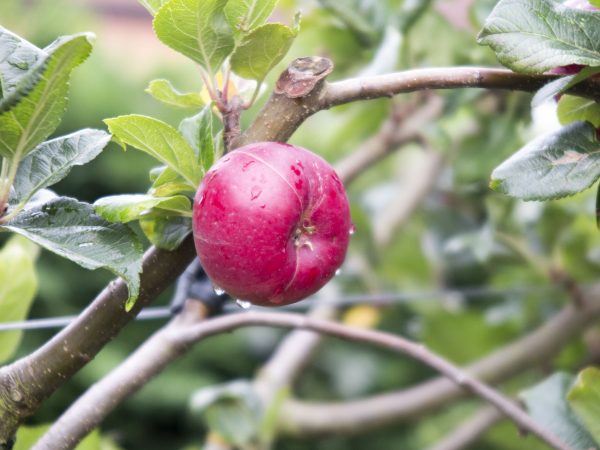
Apple trees are in Val Bourne’s top 100 plants for an eco-friendly garden.
At the end, there is list a Top 100 Plants for an Eco-Friendly Garden. I checked how many of them I have in this garden. We have around 50 of the 100. I could do better, as I like to support wildlife.
‘Re-wilding’ on holiday
Plant-lovers say that nothing teaches you more about how to grow plants than seeing them growing wild in their native countries. Many keen plantaholics choose their holiday destinations specifically for that purpose.
When I interviewed Gill and Peter Regan for The English Garden magazine, Gill told me that they’d struggled to keep peonies alive until she took a photograph of a peony growing under a tree in Iran. ‘I realised that our peony roots were probably rotting due to the damp in our garden.’ The Regans gained similar insights from trips to see Sternbergias in Turkey, bergenias in Yunnan, and plants growing wild in China, Western Australia, Peru and more.
Connect with plants in their natural habitat
I visited my brother, Hugo and his wife, Anna, in El Canuelo, a small village in Andalucia. Although I wrote about crazily wonderful gardening ideas, I didn’t think about the wild flowers.
I’ve just been sent Tony Hall’s Wild Plants of Southern Spain (Kew Publishing) to review. It’s a botanical book with clear, close-up photographs, botanical names and even a small printed ‘ruler’ on the back cover flap. ‘Take photographs of the plants you want to identify’ advises Tony (rather than pulling them up or cutting the flowers).

I’ll enjoy walking around the village and hillside near El Canuelo in Andalucia even more if I learn to spot the wild plants.
I plan to give this book to Anna and Hugo, because El Canuelo is on a fairly wild hillside. Hugo frequently goes for long walks in the countryside, as do their many guests. I feel that taking this book and identifying the wild flowers of the region is part of today’s mindfulness trend. Knowing what the plants are helps to give a sense of place. Also, as a gardener, I can learn from seeing how and where wild plants grow.
‘Re-wilding’ in the city
I recently went to a pop-up gallery in Floral St, London WC2 for an evening run by Rakes Progress and Women In Journalism. Rakes Progress is one of the new breed of independent magazines, which are proving that ‘print is not dead.’
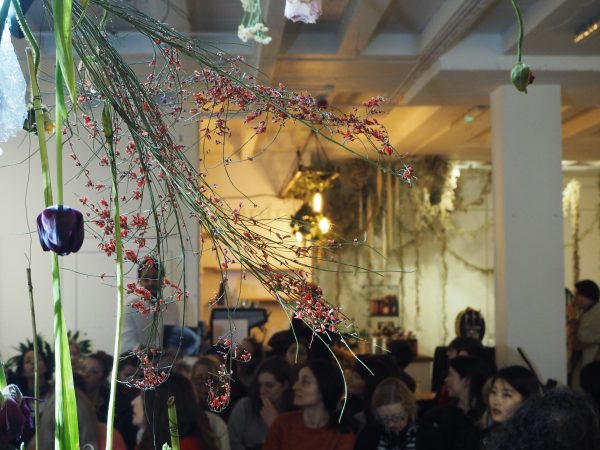
Women in Journalism seminar and hanging flower installation at Rakes Progress pop-up shop in Floral St, Covent Garden.
Somewhat appropriately, the Rakes Progress exhibition was called ‘Dead Beautiful’. The art and ‘floral installation’ showcased the beauty of dead and dying flowers. Swathes of flowers and greenery – some living, some dying, some dried -hung from the ceilings, along with branches.
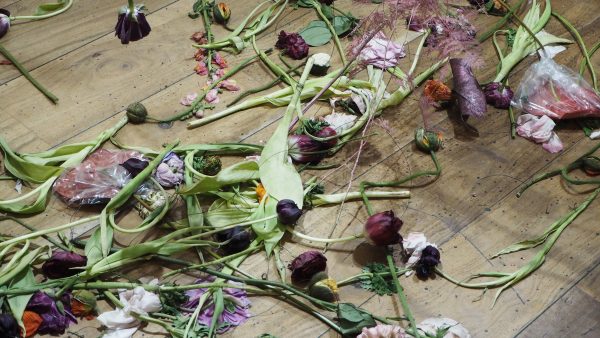
And there was a swirl of petals on the floor around even apparently conventional flower arrangements. My mother would have taken a broom to it all.

Almost ‘traditional’ flower arrangement at Rakes Progress, except that the fallen petals and dying flower are part of it, and there are more on the floor around the pedestal.
So why is this ‘re-wilding’? Well, when someone goes into a gallery like this and thinks ‘that plant looks amazing,’ it often triggers an interest in more plants that look amazing. An imaginative display (or floral installation as I think we must call it now) can lead to people buying plants for their home, balcony, courtyard or window-sill. From there, they may start to visit gardens and appreciate the impact of public parks on the environment and health.
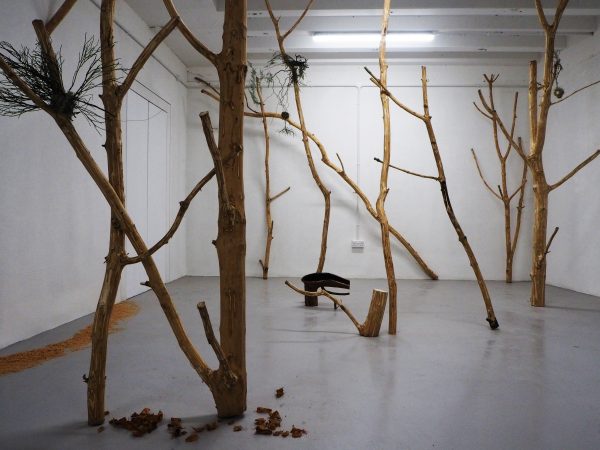
A forest in the city? Well, a floral installation to remind city dwellers of real wood and forests….including fallen leaves and bark, and a swathe of sawdust where the trees have been cut down. That’s my interpretation anyway.
What individuals do and say matters. Urban front gardens have been concreted over in their thousands to create parking spaces. But once the owners of those houses start to appreciate the beauty of plants, they are more likely to try to create at least some greenery amongst the concrete. Fashionable floral installations can get people thinking differently about plants, because they demand that you stop and stare. If only to mutter that the floor needs a good sweep.
Re-wilding taps into the cycle of life
It’s that return to the appreciation of natural materials, traditional ways and the cycle of life that makes a magazine like Rakes Progress part of ‘re-wilding’. In my view, anyway, although Tom Loxley, co-founder of Rake’s Progress, also aligns it with the ‘slow living’ movement.
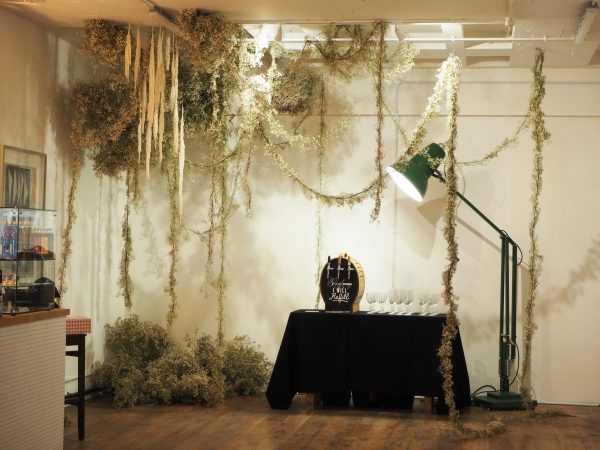
‘Re-wilding’ the London bar scene with hanging drapes of plants? In fact, this has definite echoes of the way Faversham decorates its town in the traditional hop festival….
Flip through the pages of issue 6 of Rakes Progress in this video, where I review it. It is gardening made hip, with gorgeous, brooding photography, interviews with ‘floral artists’, garden designers, craftsmen and more. There’s no advertising and no date on the issue. These magazines aim to be as timeless as books. However, unlike in coffee-table books, the writing is important, too. There are long, detailed articles, which will take you a while to read.
I’ll also be reviewing Val Bourne’s The Living Jigsaw and Tony Hall’s Wild Plants of Southern Spain in more depth on the Middlesized Garden YouTube channel.
If you’re interested in why ‘print is not dead’, by the way, we discussed how magazines are changing in response to the changing tastes of people today, especially Millenials.
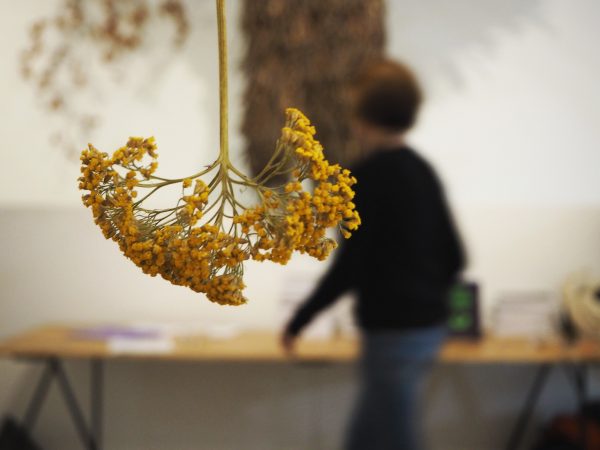
Wildflowers hanging upside down from the ceiling in a floral installation by the Urban Flower Company at the Rakes Progress popup shop.
Gardening writer, Alice Vincent, herself a Millenial, said that her generation don’t want to hear about shopping. ‘We either rent or have very small flats, so we’re more interested in experiences or something we can talk about.’ She also thought that the fashion for gardening amongst the young is a trend that will stick around. ‘Clean eating was a fad, and is now considered to be “over”, but it drove the current growth in veganism.’

Garden tools as part of the Rakes Progress art installation. I love it – this is an idea that would translate well into a home. If you don’t have space for a garden shed, hang your tools on the wall and appreciate their beauty. I particularly like that these are not all vintage tools – there are brand new ones there too.
So why does re-wilding matter to you?
Scientific tests have proved that slowing down to enjoy all your senses and ‘mindfulness’, helps stress, concentration and sleep. But to take it back to Val Bourne’s book – we are all part of the living jigsaw. We need bees and pollinating insects, and they need flowers and plants. At some point in the chain, even the less attractive bugs and beings play their part.
We don’t necessarily know how much each species contributes to the jigsaw. And we certainly can’t foretell the consequences of one or more disappearing from the earth. Even when re-wilding is a token activity – in an art installation, for example – it still has a message for us all. Let me know what you think, either in the comments below or on Facebook or Twitter.
Pin for reference:
The post What is ‘re-wilding’ and why does it matter to you? appeared first on The Middle-Sized Garden.
from The Middle-Sized Garden http://www.themiddlesizedgarden.co.uk/re-wilding-matter/
Saturday, 20 January 2018
Saturday quiz
Can you name all the plants in these lovely old botanical illustrations?

Post your answers in the comments below, reply on our Instagram, comment on our Facebook page, or tweet at us. Answers tomorrow.
from #wildflowerhour http://www.wildflowerhour.co.uk/blog/2018/01/20/saturday-quiz-13/
Friday, 19 January 2018
Marsh helleborine
Every Friday, we introduce #wildflowerhour members to a different beautiful native orchid. This week it’s the turn of the Marsh Helleborine, Epipactis palustris. It’s a fabulous orchid, as showy as any of the exotic members of the family that people (try to) grow on their windowsills at home. And it grows wild in this country. It’s amazing how few people are aware of how stunning our native flora is.
Here’s a short video, which you can also watch on our Twitter feed, our Facebook page, and our Instagram story:
It’s Friday so it’s orchid day! Meet the Marsh Helleborine, Epipactis palustris in this video – and tweet us pictures of your own Marsh Helleborine finds. pic.twitter.com/TLHBzN0Ye7
— wildflowerhour (@wildflower_hour) January 19, 2018
And here are your own Marsh Helleborine finds. If you haven’t yet seen this amazing plant, why not ask a #wildflowerhour member where they found it, so you can enjoy its exotic-looking beauty for yourself.
My first helleborine, seen in Highland Perthshire. Mesmerisingly colourful orchids combined with a mesmerisingly colourful alkaline flush was a little overwhelming. A site I'll be aiming to drop by again this year! pic.twitter.com/lM7muIJkOB
— Gus Routledge (@PinkfootedGus) January 19, 2018
Such a showy plant! Here's a fine specimen of Epipactis palustris from dune slack at Rosepenna, Co. Donegal pic.twitter.com/hUdquurD6a
— Rory Hodd (@NimbosaEcology) January 19, 2018
My favourite patch of Marsh Helleborines. Just 1km walk along coast from my old house in Seaton Devon. I try and go for a look at them every year. pic.twitter.com/rz32Jj7CNf
— Karen Woolley (@Wildwingsand) January 19, 2018
I was thrilled to see my first Marsh Helleborines on an Orchid filled outing with the Warrington Plant Group at Nob End SSSI. There were carpets of them! pic.twitter.com/xhdq9eZ9AJ
— Rebecca Wheeler (@Rebecca42041942) January 19, 2018
Here are a few of my 2017 Marsh Helleborine photos from Laois. Makes me sad looking at them because their marsh was reclaimed for grass. pic.twitter.com/NsFO8Zeiy8
— Martine Brennan (@BrennanMartine) January 19, 2018
from #wildflowerhour http://www.wildflowerhour.co.uk/blog/2018/01/19/marsh-helleborine/
Thursday, 18 January 2018
Sunday, 14 January 2018
Podcast: Winter trees and wasp orchids
Do you think winter is for staying indoors? You’re wrong: it’s some botanists’ favourite time of the year for examining plants which seem quite asleep. In the latest episode of the Wild Flower (Half) Hour podcast, Kevin Widdowson explains how to identify winter trees – and you can read his wonderful post with more information on winter tree ID here. Isabel Hardman also talks to David Steere, better known to most of us as @barbus59, about how he became quite so good at botany so quickly, hears Lydia Massiah’s tale of her wasp orchid hunt, and discovers what you all found on your New Year Plant Hunt.
You can listen to this podcast on iTunes, Acast, Stitcher, Spotify, and most other good podcast platforms. If we’re not on your favourite podcast player, please let us know. And please do rate or review the show as it makes a huge difference to how many other people are able to find it.
from #wildflowerhour http://www.wildflowerhour.co.uk/blog/2018/01/14/podcast-winter-trees-and-wasp-orchids/
Reading council likely to approve £12 million for bus lanes and traffic lights
from getreading - Reading & Berkshire News http://www.getreading.co.uk/news/reading-berkshire-news/reading-council-likely-approve-12-14145905
Reading FC fan gallery from the draw at Hull City
from getreading - Reading & Berkshire News http://www.getreading.co.uk/sport/football/football-news/reading-fc-fan-gallery-draw-14152873
Natural dye from your garden – beautiful, creative and easy
Yasmin Hossain makes natural dye from garden plants. She uses it to dye beautiful silk and wool fabrics.
And I believe that grow-your-own dyes from garden plants is a trend that will grow enormously in popularity in the next few years.
It’s creative and almost anyone can do it, although there’s a certain amount of experimentation involved. If, for example, you’re a knitter or crafter, how much more exciting is it to dye your own wool and felt? Especially as you’re using ingredients that would otherwise be thrown away, such as vegetable skins and dead flower heads.

The soft pink blanket is dyed with natural dye made from avocado skins and stones. The yellow one is dyed from daffodil heads from Doddington Place.
Yasmin experiments with flower dyes in her own home. She is also one of a partnership in Juniper & Bliss who make clothes and bedding from natural organic materials, dyed with plant dyes. Juniper and Bliss aim to be completely sustainable and ‘zero waste’. ‘We want to leave the lightest environmental footprint,’ says Yasmin.
Fabrics are made and dyed by small scale producers and artisanal co-operatives around the world, such as Scottish micro-mills or co-operatives in India. Clothes and bedding are then sewn in atelier protege in Belgium. (This roughly translates as ‘protected workshop’, along Fair Trade principles.)

Avocado skins and pips, given to Yasmin by a local cafe, waiting to be distilled into dye in Yasmin’s kitchen.
Flowers and vegetable skins for dyes at home
At home in Kent, Yasmin brews up avocado pips and skins from a local cafe and asks beautiful local garden Doddington Place if she can have their daffodil deadheads in late spring. She is even drying a bunch of flowers sent to her as a gift.
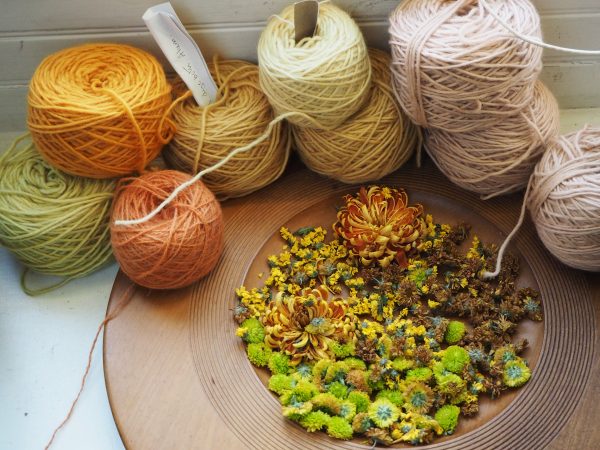
These are dried flower heads from a bunch of flowers given to Yasmin as a gift. They will soon be brewed up to create beautiful, natural colours for dye.
I recently did a video on dyeing tablecloths with Dylon, but it can’t be used for wool or silk. So when I heard about Yasmin’s natural dyeing, I was keen to hear more.
I wrote about how to create stunning dyes from your garden plants after interviewing a friend in Australia who is ‘mapping her garden with dye plants.’ And in the RHS Chelsea Flower Show 2016 a Dyer’s Garden was featured for the first time (reviewed here by the Reckless Gardener.)
And now that cut flowers are joining the grow-your-own movement, along with a desire to minimise waste and chemicals, I think the trend towards using natural dyes in your own home can only grow and grow.
First choose your flower or plant
I joined Yasmin for a dyeing session using avocado skins and pips. The principles of natural dyeing are approximately the same for many flowers and plants.
However, natural dyers are always trying things out and tweaking their recipes, so keep a note of how your natural dye turns out. More avocado skins and pips? A longer boiling time? Do you need to add a fixative (known as a mordant)? Each recipe is different, so let’s go from start to finish with Yasmin’s avocados.
If your household eats alot of avocados, you can save the skins and stones, but Yasmin gets hers from a local cafe. The discarded material sits in a bowl in her living room or kitchen until she’s ready to brew up.
I’ve done a video showing the process, which you can see below:
Brew it up
Yasmin added a few handfuls of avocado skins and stones to a large stainless steel pan. She added water, to a depth of two to three times. Then she brings it to the boil and simmers it for around an hour until she estimates the dye is strong enough.
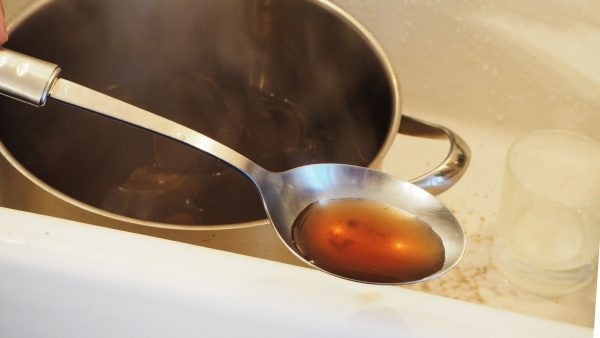
Check the strength of the dye with a spoon. Just over an hour later, it looks about right to Yasmin.

Meanwhile, in another stainless steel bowl, the natural wool is soaking in water.
The wool or cotton needs to be wet if it is to take the dye evenly, so soak it in another bowl while you’re making the dye.
The next stage – add the natural dye to the wool or fabric
Squeeze out the cotton or wool so that it is damp, but not soaking.
Then strain the dye liquid. You may be able to brew up another dye from the same material, and the ‘2nd dye bath’ will come out slightly different (usually paler, not surprisingly).
Allow the dye liquid to cool a little before adding the fabric.

Remove larger pieces with a slotted spoon, then drain the liquid with a sieve to get the detritus out.

Return the pan to the heat, but be careful not to allow it to boil for more than a few seconds or it will felt the wool.
Swirl the wool or fabric around in the pan so that the liquid is evenly distributed. Then return the pan to the heat, bringing it very briefly to the boil.
Turn it down to simmer immediately and simmer for around an hour. Don’t let it boil or it will felt the wool.
Not all natural dyes need to be boiled. Yasmin had a large pot of eucalptus leaves infusing in her kitchen, and these won’t be heated up.
When the wool is approximately the shade you want, lift it out of the dyeing water, and hang it up to dry. It will probably be paler when dry, so experiment a bit.
I’d say the process is similar to making marmalade in terms of time and effort. It takes quite a long time, because of all the simmering and steeping, but for most of that time, it’s just brewing away without much interference from you. We were able to enjoy a delightful lunch while the dye was boiling and simmering.
Finally…
When you judge that the dye is ready, drain the dye and gently wash the wool in a very mild detergent. Wool doesn’t like going from one extreme of temperature to another. So allow it to cool a little and also use warm water for washing it. Once any excess dye has been washed out, hang the wool or cotton up to dry.
More colours from natural plant dyes

The orange swatch was made from Black Cat dahlia, which I also have here. It’s a very deep red -so plant colours don’t always turn out the way you expect.
Plant dyeing is very low tech, and plant dyers experiment with their recipes and take notes. If you want to read more before starting, India Flint is the guru on natural plant dyeing. Start with her book Eco Colour – Botanical Dyes for Beautiful Textiles.
The Modern Natural Dyer, A Comprehensive Guide to Dyeing Silk, Wool, Linen and Cotton at Home by Kristine Vejar is also highly rated. And gardeners who want to think about what to plant in their garden should enjoy Rita Buchanan’s The Weaver’s Garden.
Note: links to Amazon are affiliate links, which means I may receive a small fee if you buy through them, but it won’t affect the price you pay.
There are also workshops where you can learn about dyeing. These include day and weekend workshops from Flora Arbuthnott. Craft Courses is a website that lists dyeing, spinning and other crafting courses around the UK.
Pin for reference:
The post Natural dye from your garden – beautiful, creative and easy appeared first on The Middle-Sized Garden.
from The Middle-Sized Garden http://www.themiddlesizedgarden.co.uk/natural-dye-from-your-garden-beautiful-creative-and-easy/
Saturday, 13 January 2018
Winter Trees
Just because deciduous trees don’t have leaves in winter doesn’t mean you can’t still have a go at identifying them. In fact, there is quite a science to winter tree identification from terminal twig characters. There are a few field guides out there that can help you on your way but it is best to get familiar with a few basic terms first. So………

This indicates how the buds are positioned on the twig. The point where something happens is called a node. Where one bud arises from the node it would be called ‘alternate’, whereas ‘opposite’ would be used where two buds emerge from the node.

Looking at the buds at the end of the twig can be a useful feature for narrowing down your identification. The most basic form is a terminal bud. This is where a single bud is situated at the end of the twig. Alternate bud arrangements can often end in a false terminal bud. This means that there is a section of twig growing beyond the the final bud. Clustered buds at the tip usually indicate either oaks or cherries.

The bud scales are there to protect the embryonic leaves or flowers contained within the bud. Their number and position can be diagnostic of the genus. For example, willows have only one visible scale, limes have two asymmetric scales and maples have more than four scales always in pairs. The position of the scales in relation to the leaf scar can also be important. Poplars always have a scale emerging directly above the leaf scar.

The leaf scar is the impression left at the point of abscission between the stem and the fallen leaf. It is a very important identification feature. Look out for the shape and position.
Contained inside the leaf scar are the vascular bundle scars. These indicate where the vascular system entered and exited the leaf. Their position in relation to the leaf scar is a key feature to observe.

Some trees come complete with their own armoury. Knowing how to separate the three types of weaponry can greatly help you to narrow down your choices:
Thorns are modified branches and sit above the leaf scar. They are connected to the vascular system of the tree.
Spines are modified leaves and sit below the leaf scar. They are also connected to the vascular system.
Prickles are part of the epidermis, the outer layer of the twig. These are situated anywhere along the twig and are not connected to the vascular system.
Yes, you’ve got it; roses don’t have thorns, they have prickles!

It may seem destructive but taking a linear section through the twig can reveal some clues to the identification of your tree. There are three main types of pith structure. The pith is usually continuous but in some species it can have partitions. These partitions are either segmented (where the areas between partitions are filled) or chambered (where these areas are hollow).

Taking a transverse section through the twig will reveal the shape of the pith. Most are round but sometimes you come across triangular ones, hexagonal ones and even some that are star shaped.
Field Guides
Now that you’ve got the hang of the terminology, why not try one of these field guides for your winter tree travels.
A Guide to the Identification of Deciduous Trees and Shrubs in Winter
Winter trees: a photographic guide to common trees and shrubs
Species Recovery Trust Winter Trees Key
If you plan to download the Species Recovery Trust guide, please consider making a donation to the charity.
from #wildflowerhour http://www.wildflowerhour.co.uk/blog/2018/01/13/winter-trees/
Saturday Quiz
Can you name all the plants in these lovely old botanical illustrations?

Post your answers in the comments below, reply on our Instagram, comment on our Facebook page, or tweet at us. Answers tomorrow.
from #wildflowerhour http://www.wildflowerhour.co.uk/blog/2018/01/13/saturday-quiz-12/
Thursday, 11 January 2018
Wednesday, 10 January 2018
Teenager who died at Reading Festival 'just wanted somebody to help him' says grandmother
from getreading - Reading & Berkshire News http://www.getreading.co.uk/news/reading-berkshire-news/teenager-who-died-reading-festival-14136771
Tuesday, 9 January 2018
The A to Z of international food in Reading
from getreading - Food & Drink http://www.getreading.co.uk/whats-on/food-drink-news/z-international-food-reading-14112527
Sunday, 7 January 2018
7 January
Thank you everyone who took part in the first #wildflowerhour of 2018! Here are some highlights from a colourful Sunday night.
from #wildflowerhour http://www.wildflowerhour.co.uk/blog/2018/01/07/7-january/
The most read stories in Reading for the first week of 2018
from getreading - Reading & Berkshire News http://www.getreading.co.uk/news/reading-berkshire-news/most-read-stories-reading-first-14121761
How to find a gardener who’s perfect for your garden
What’s the first thing you think about when you decide to find a gardener?
Is it ‘how much does a gardener cost?’
Or ‘how do I find a gardener who will make my garden look completely wonderful?’
Let’s get the secret doubts over….
Am I imagining it, or is there just a smidgeon of embarrassment about getting someone else to do your gardening?
In the nineteenth century, even very modestly-off families expected to pay someone to help out. But by the 1970s, an uneasy middle-class guilt emerged – in Britain, at least – about paying other people to do chores you could do yourself. Or you may feel that you’re a bit of a fraud if you get someone else to do the hard work – as if it’s ‘not your garden’ any more.
Recently I’ve been asking fellow garden writers what they think stops people from having the garden they really love. ‘Well, I know what stops me,’ said garden writer/photographer Annie Green-Armytage.’ It’s lack of time. Finally, we decided to get a gardener.’
I met Annie when we were both short-listed as Gardening Journalist of the Year in the 2017 Property Press Awards. So if an award-shortlisted garden writer can admit she needs a gardener, so can we all.
Essential questions to ask yourself…
The first thing to establish – before you find a gardener – is what you want him or her to achieve. I asked the All Horts Facebook Group, which has many professional gardeners, what the main issues between gardener and client are.
Almost everyone said that communication is the biggest problem. Gardener Charlotte Bell advises you to ‘talk to your gardener so everyone knows what to expect. My clients range from the horticulturally knowledgeable to those who just want a nice looking garden with minimum input from them’, she says.
So do you want a stunning garden, full of must-have plants and the latest trends? Or a tidy and well maintained green space that you don’t need to think about?
Do you want a gardener who will do what you do, but save you time? Someone to take your garden to the next level? Or just someone strong enough to do the jobs you can’t manage?
Do you need to find a gardener with qualifications?
Would you go to a hairdresser with no qualifications? Or an accountant or a plumber? Would you try to cut your own hair, do your own sums and mend your own boiler, or do you pay someone to do it better than you can?
Qualifications to look for include RHS, City & Guilds/NPTC, Lantra, and qualifications from horticultural colleges.
Some gardeners also learn by working for more experienced gardeners, such as in a garden that’s open to the public. So it’s not just about the paper qualifications, but who a gardener has worked with or for.
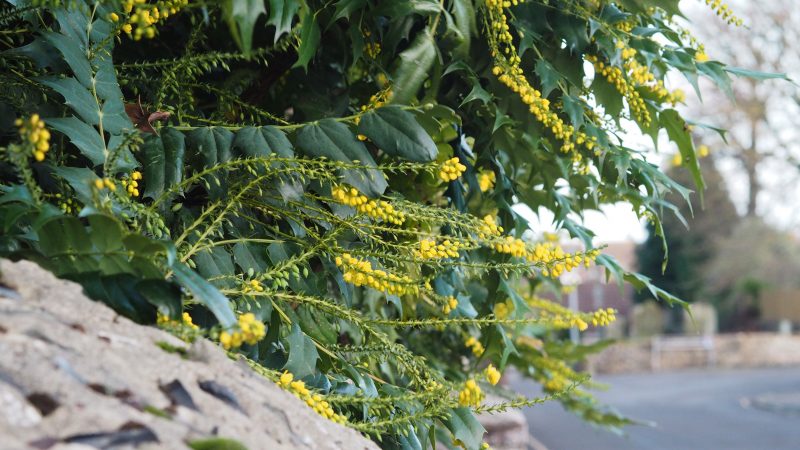
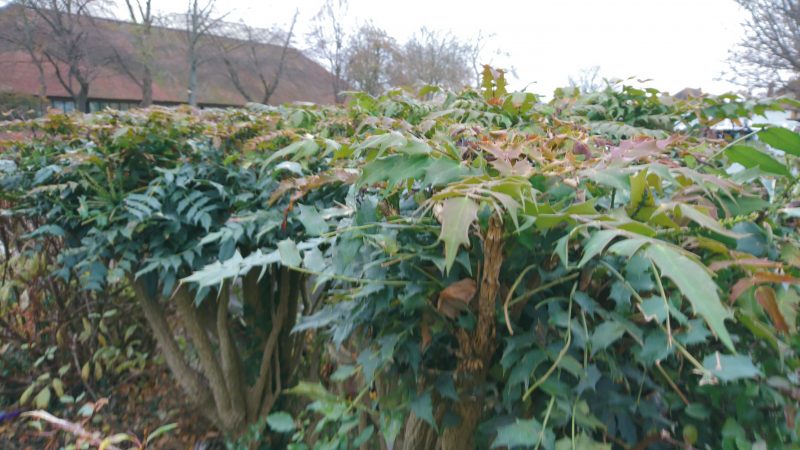
Essential questions to ask the gardener….
Warning! Not all gardeners are the same.
Gardeners can sometimes very roughly divide into ‘hedges/lawns’ and ‘plants’ (possibly otherwise known as ‘equipment’ or ‘flowers’).
People who mow lawns, trim hedges and work on trees may not necessarily have the experience you want when it comes to flower beds.
And, on the other hand, I have met several professional gardeners who are brilliantly creative and knowledgeable with plants, but who ‘don’t do lawns’.
So you may have to decide whether to get a good horticulturalist and mow the lawn yourself, or the other way round.
Ask gardeners, when you’re interviewing them, about their expertise, enjoyment or qualifications in both areas. There are gardeners who are qualified in both handling machinery and planting, but even they may have tasks they prefer.

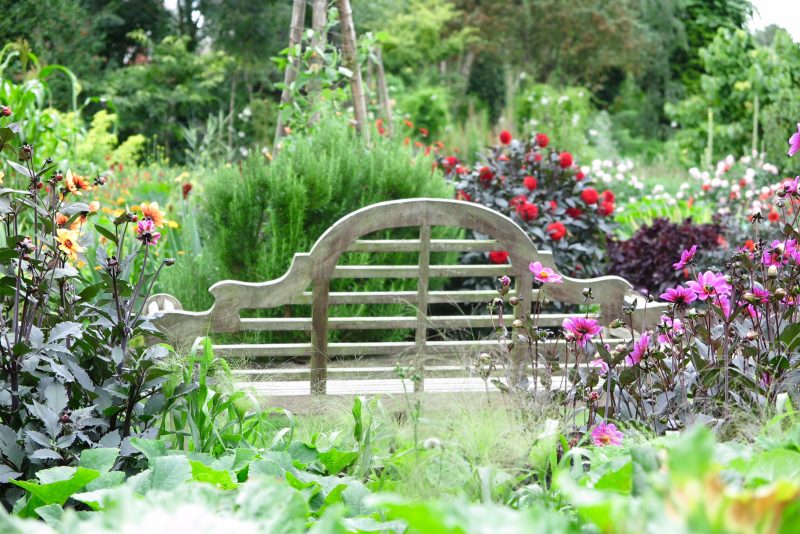
Think in the medium and long-term…
If it’s beautiful borders you’re after, then a certain amount of planning is involved. Gardener Jeni Cheverton says ‘clients may not realise that in plant care, you’re usually thinking 2-3 years ahead, in terms of pruning management, herbaceous divisions, or the spacing of new plantings to allow for growth.’
Gardener Miranda Munday says ‘we work 1-3 years ahead to bring a garden up to scratch. It involves getting to know the garden, enhancing it, changing it and being adventurous (up to a point!)’
But can’t we just find a young person (at the minimum wage?)
Hmm – let us know how you get on with that one. You may have a magical source of reliable young people willing to work for the minimum wage, but I do not.
And will you be standing over this mythical being for hours, explaining exactly how to prune a rose bush and plant bulbs?
Or will you just hand the Young Person the chainsaw and hope they trim the hedges rather than lop their own foot off? In which case, may I remind you about Health & Safety at Work legislation and ask you to check your insurance?
Finally, remember that work experience trainees grow up. They soon turn into professionally qualified young men and women, often with young families. They will need to charge more or find other jobs. Those who are not interested in that sort of thing will disappear off around the world.
So you will have to return to your magical supplier of Young People quite frequently.
Oh, well…perhaps a retired gardener who just wants to work a few hours a week…?
Did I hear the unspoken phrase ‘for peanuts..’ at the end of that question? Or do we think that the recently retired are still charging 1990s prices?
If you retire in your mid to late sixties, there’s probably a limit to how long you want to ‘keep your hand in.’ Health or family issues may emerge.
But the retired gardener who just wants ‘to do a few hours’ (and who hasn’t raised his prices for decades) does exist. At least, I have heard of one, although he doesn’t seem to be around just at the moment….
OK, I get it. So how much does a gardener cost?
The Gardeners Guild, the association for qualified gardeners, points out that most self-employed tradesmen (eg plumbers, electricians, painters, etc) need to earn at least £150 a day. They say that usually means charging you £20-£40 an hour.
Gardeners need to invest in training. They have to buy good quality tools and maintain them. And they travel to different jobs, so they can’t afford to do less than two hours at any one job. Four hours is probably more practical for them.
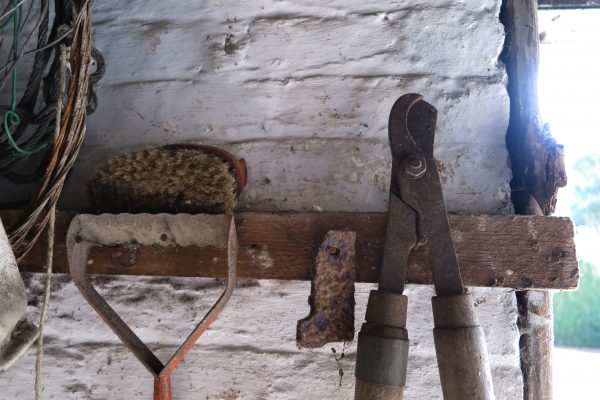
Are your tools up to date and well maintained? Most gardeners find they need to bring their own professional-standard tools. Which cost money to buy and maintain.
However, an experienced gardener with good tools can probably achieve much more in 2-4 hours – and do it better – than someone inexperienced who borrows your tools. Your tools may not be the best, or may not be well maintained.
Andrew Palmer, Lawn Ranger Ground Maintenance, charges £22/3 per hour plus refuse removal charges. ‘One-off jobs like hedge cutting are budgeted separately. I’ve invested thousands in tools, plus running costs of my company and wages. The days of £12/15 an hour are long gone, I leave that to one-man bands or the recently retired.’ Admittedly, Andrew is based in South East England, which – along with the big cities – will be the most expensive part of the UK to employ a gardener.
If you just want a regular job done, like mowing the lawn, then the gardener will probably charge you on a fixed basis rather than by the hour.
But what if I pay cash?
Your gardener will need to pay tax, however you choose to pay them. It’s illegal not to pay tax and National Insurance.
Not paying tax also affects whether someone can get loans, credit or a mortgage.

It’s not fair to ask someone to break the law on your behalf.
How many hours a week do I need a gardener for?
All Horts member and gardener John Bates says: I do gardens of up to 1-2 acres and do everything in them, but that means 6-8 hours a week. I work year round so can’t accept a 9 months paid and three months off. I expect customers to be engaged with plans for improving the garden and I make recommendations to make the garden better not just for a quick buck.’
How much time your garden takes is also a question of what you plant and how you design it. My garden, which is about one-fifth of an acre, takes about two hours a week to garden, plus mowing the lawn. Annie Green-Armytage has replaced some of her high-maintenance beds with easy-care shrubs and perennials, rather than plants that need fussing over.

The Middlesized Garden needs about two hours of gardening a week, plus mowing the lawn.
John Bates suggests you think of a gardener as an ‘asset manager’. ‘If your garden is an asset to your home, and your home is your biggest investment, then you should pay gardeners the way you pay an asset manager.’
I did some sums, which are not very accurate, to find out how much you would pay a gardener if you paid them the same sort of percentage you pay your asset manager. There are no reliable figures on how much value a garden adds to a house, and quite a lot of other variables. But my rough calculations on the back of an envelope came to…£20-£35 an hour!
John might ask why fund managers earn so more than that, but that is because fund management can be scaled up (you can manage hundreds of funds at once), while you can only garden one piece of earth at a time.
Is there anything else I need to think about?
Parking. This can be a problem for gardeners in cities and towns. If gardeners are bringing tools, they need a car.
Insurance. A professional gardener should be insured, but you also need to check your own insurance, especially if power tools or diggers are involved. Gardening involves a surprisingly high number of accidents.
You (or your gardener) need a licence to use some power tools and other machinery.
Now where do I actually find a gardener?
The Gardeners Guild has a list of qualified members.
Also many gardeners learn by working or volunteering at professional gardens (ie those that open to the public). So it is probably worth contacting good gardens near you to see if anyone in their gardening team is looking for more work.
And check with neighbours who have the kind of garden you like. A gardener who has a full book of clients may be able to fit another one in if they live really close to a current client.
Lastly, there’s a huge growth in community gardening. If you have a community garden near you, they should be tapped into the gardening expertise in your neighbourhood. Ask whoever runs it to put out a call for gardener (and quote the rates you intend to pay!) in their regular newsletter if they have one.
The same goes for Facebook and Twitter. However, in my experience, jobs on Facebook and Twitter are widely shared and get a huge response, but in the end, not much seems to come of it. Still, it’s worth trying.
Lastly, may I mention the loo…?
Your house and garden is your home. But it’s also your gardener’s work place. When you go to work, do you expect to use your employer’s ‘facilities’?
And has any employer ever suggested that you should “go” behind the shed or outside?
I was completely amazed to come across a long and lively Facebook thread from gardeners whose clients don’t allow them to use the loo. Even when the loo is downstairs and they have offered to take their boots off! As gardener Jeni Cheverton says: ‘We can’t all pee behind a bush.’

This was originally a Victorian ‘gardeners’ loo.’ However, in today’s middle-sized gardens, such luxuries are a rarity….although I can see that there may be a problem if you are out at work and have complicated security arrangements.
And tea…
There was also alot of comment about people who don’t offer their gardeners tea, hot drinks or even a glass of water. Many gardeners take their own thermos, but if you are working outside for 4-5 hours, especially in the winter, fresh cups of hot tea or coffee are important.
However, at the other end of the spectrum, I have also seen professional gardeners posting photos on Instagram of tea, cake and Christmas presents from ‘lovely clients’.
As many good gardeners quickly get fully booked, it is worth being a ‘lovely client’ and getting out that tea, coffee and cake!
Finally, say when you like what your gardener has done – Miranda Munday echoes a number of others when she says ‘appreciation is wonderful.’
Let me know your tips on finding a good gardener, or if you are a gardener, leave a comment to add your point of view.
PS I am starting a new series on the Middlesized Garden YouTube channel called ‘Middlesized Garden of the Month.’ It will be uploaded on the first Saturday of every month.
The aim is to show you middle-sized – but beautiful – gardens that you might not otherwise see, either because they don’t open to the public or, if they do, they are only in small local schemes. But these gardens have great ideas and have the same challenges that you do. The first one is here:
Pin for reference:
The post How to find a gardener who’s perfect for your garden appeared first on The Middle-Sized Garden.
from The Middle-Sized Garden http://www.themiddlesizedgarden.co.uk/how-to-find-a-gardener-whos-perfect-for-your-garden/
Saturday, 6 January 2018
11 Reading restaurants you can take the family to
from getreading - Food & Drink http://www.getreading.co.uk/whats-on/food-drink-news/11-reading-restaurants-you-can-14118413
Saturday quiz
Can you name all the flowers in this beautiful old botanical illustration?

Post your answers in the comments below, reply on our Instagram, comment on our Facebook page, or tweet at us. Answers tomorrow.
from #wildflowerhour http://www.wildflowerhour.co.uk/blog/2018/01/06/saturday-quiz-11/
Friday, 5 January 2018
getreading to merge into InYourArea
from getreading - Reading & Berkshire News http://www.getreading.co.uk/news/reading-berkshire-news/getreading-to-merge-into-inyourarea-14118069
Top 10 things to do in and around Reading according to Tripadvisor
from getreading - What's On News http://www.getreading.co.uk/whats-on/whats-on-news/top-10-things-around-reading-14107479
Thursday, 4 January 2018
Ultimate guide to wedding fairs around Berkshire in 2018
from getreading - What's On News http://www.getreading.co.uk/whats-on/whats-on-news/ultimate-guide-wedding-fairs-around-14111264
Wednesday, 3 January 2018
Emergency repairs to Oxford Road store after Storm Eleanor damages roof
from getreading - Reading & Berkshire News http://www.getreading.co.uk/news/reading-berkshire-news/emergency-repairs-oxford-road-store-14109831
Hour by hour weather forecast for Reading on Wednesday as Storm Eleanor passes Berkshire
from getreading - Reading & Berkshire News http://www.getreading.co.uk/news/reading-berkshire-news/hour-hour-weather-forecast-reading-14106718
Tuesday, 2 January 2018
Party like its 1985 in Reading plus more fun things to do this weekend
from getreading - What's On News http://www.getreading.co.uk/whats-on/whats-on-news/party-like-1985-reading-plus-14102942
Hour by hour weather forecast for Reading as Storm Eleanor set to batter Berkshire
from getreading - Reading & Berkshire News http://www.getreading.co.uk/news/reading-berkshire-news/hour-hour-weather-forecast-reading-14105178
Meet the first babies born in Reading in 2018
from getreading - Reading & Berkshire News http://www.getreading.co.uk/news/reading-berkshire-news/meet-first-babies-born-reading-14104012
Monday, 1 January 2018
See the criminals locked up in Berkshire in December
from getreading - Reading & Berkshire News http://www.getreading.co.uk/news/reading-berkshire-news/see-criminals-locked-up-berkshire-14085189
Introducing #herbologyhunt
If you’re reading this site, it’s probably because you have at least a fleeting interest in nature. Yet wild flowers are not just disappearing from our countryside; they’re also vanishing from children’s lives and their language. The Oxford Junior Dictionary has been cutting out the names of common plants over the past few years, because children just don’t encounter or know bluebells and other wild plants any more.
We want to change this in 2018. Wild flowers are fascinating and magical, and children deserve to have their lives and understanding of the world enriched by meeting them.
So if you want to teach the children in your life about the magic of wild flowers, please join in with the #HerbologyHunt, the junior section of #wildflowerhour.
Every month, we will be releasing a new spotter sheet of five wild flowers for children to find, and descriptions of what they look like. We will also be releasing lesson plans and having various junior challenges.
To share your finds, or those of your children – just post them on Twitter or Instagram using the hashtag #herbologyhunt or in our new Facebook group.
And here is the spotter sheet for January. Happy hunting!
(Click on the image to download the sheet)
from #wildflowerhour http://www.wildflowerhour.co.uk/blog/2018/01/01/introducing-herbologyhunt/



